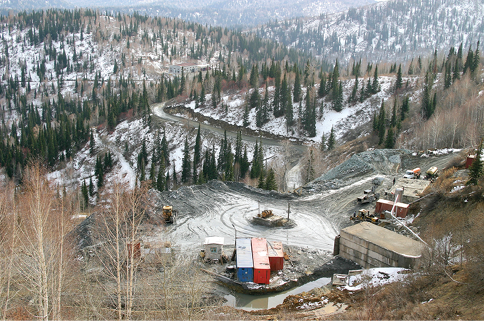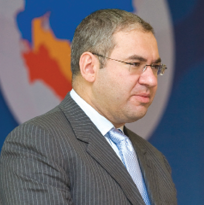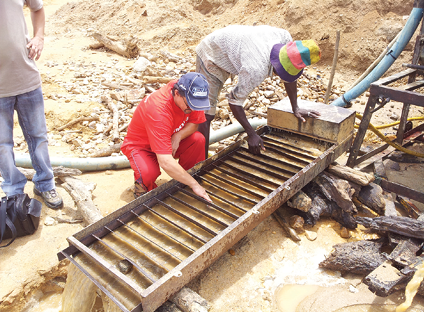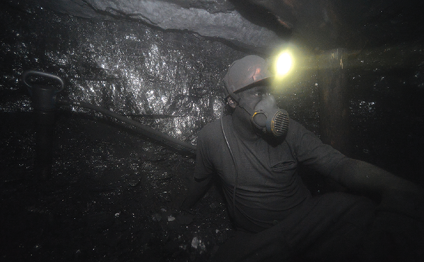Time will tell if this large, landlocked country can overcome lack of exploration, obsolete mining laws and widespread illegal mining in order to attract foreign investment
By Vladislav Vorotnikov

Kazakhstan has seen little gold exploration activity over the past 30 years. (Photo: AO Kazgeology)
Despite low market prices for precious metals, Kazakhstan’s government said it is not going to deviate from the development of its domestic gold industry; in fact, one of the main targets of the program is to elevate gold production sufficiently to boost Kazakhstan into the ranks of the 10 largest gold-mining countries within a decade.
Albert Rau, vice minister for investment and development of Kazakhstan, said earlier this year that his country plans to increase gold production in 2016 by 6.3% to 60 metric tons (mt), and then aim for an increase of 31.6% to 75 mt in 2018–2019.
The longer-term objective is 130 mt, which the government believes can be achieved around 2025–2030. Kazakhstan, in terms of volume of gold mining, currently ranks 17th in the world and third in the CIS. Reaching this long-term gold production goal would make it the ninth largest producer in the world and second in the CIS.
According to the country’s vice minister of industry and new technologies, Nurlan Sauranbayev, Kazakhstan is well-placed for its planned production increases; it has reserves of gold in categories A, B and C1 of 1,159 mt; reserves in the C2 category are reported at 1,107 mt; and projected reserves amount to 9,565 mt, including 7,725 mt in gold deposits and 1,840 mt in complex gold-containing deposits.
Several studies suggest its actual reserves may be much larger, since exploration activity in Kazakhstan has been almost non-existent for about 30 years, providing potential investors with attractive odds for finding new deposits there.
The government indicates that Kazakhstan’s current raw material base for gold mining includes 293 deposits—primarily small ones, with reserves of up to 25 mt; and medium-sized, with reserves of 25 mt to 100 mt. The overall value of gold in Kazakhstan’s deposits amounts to $48 billion.

Polymetal has turned its attention toward asset acquisition and expansion in regions east of Russia (Photo: Polymetal International)
Looking for Investors
Kazakhstan has, for several years, been actively seeking to attract foreign investors for development of its mining industry. It had success in 2015 when Polymetal International, a subsidiary of Polymetal Group, purchased the Kyzyl deposit for an estimated $100 million.
This acquisition may enable Polymetal to boost its gold production in Kazakhstan from 3 mt to 15 mt by 2019 on the strength of capital investment amounting to $500 million, according to Polymetal Group CEO Vitaly Nesis.
Nesis said construction at the deposit should be under way by the end of 2016 and might be finished in late 2018. Overall capacity of the project is 11 mt to 12 mt of gold concentrate per year, which would make the company the second largest producer in Kazakhstan. He noted that Polymetal’s plan initially includes mining but not processing concentrate on-site—instead, it will arrange for processing by an outside party. This will enable the company to develop the project in stages, reducing overall project startup time and cutting capital costs.
This strategy is intended to avoid the mistakes made by the previous owner of the Kyzyl mining license, who failed under the weight of high capital costs, a need for sophisticated technology and prolonged project startup time, said Nesis.

Most of the gold produced in Kazakhstan comes from underground operations. (Photo: KazMinerals)
Polymetal Group’s management intends to ship gold concentrate to processing facilities in China, either via the port of Vladivostok in Russia, or by trucking it to the eastern border of Kazakhstan and transloading it for further travel via Chinese railways.
According to Nesis, logistics costs for this approach have not been finalized, and the company will have to obtain special dispensation from Kazakhstan’s government as current mining legislation forbids export of gold-containing materials to foreign processing facilities.
Reserves at Kyzyl are estimated at 326 mt, but development has been stymied in the past due to problems posed by high carbon and arsenic content in the ore, the latter of which brings risk of environmental pollution. According to Nesis, shipment abroad of concentrate for processing should avoid pollution issues.
Nesis describes Kyzyl as one of the top gold deposits in the world. For comparison, the Varvarinskoye deposit, Polymetal’s top profit maker, has an average grade of just 1 g/mt Au, while Kyzyl’s average grade is 7 g/mt.
Implementation of projects such as Kyzl have some unique challenges in Kazakhstan, such as a governmental requirement to conduct some portion of refining in Kazakhstan, and mandatory sales of the produced bullion to the National Bank. The company plans to meet these requirements by returning processed concentrate to a facility in Kazakhstan for refining.
Internally, Polymetal will shift attention—at least temporarily—away from finding new assets in Ukraine and Mongolia, turning instead to Kazakhstan and Armenia. In March, Polymetal paid $25 million to purchase the Kapan gold mine, located 320 km from Yerevan, the capital of Armenia.
Launching of large-scale mining at Kyzyl might roughly parallel the beginning of a “Silver Age” in the world’s gold market, according to Nesis, who maintains that the market’s “Golden Age,” featuring rising prices and production, occurred in 2000–2010; but now, with falling prices and rising production, it’s in the “Iron Age.” He believes that over the next four years, the worldwide volume of gold mining will drop 3%–4% per year on average, and hopes that following this period of decline, the market’s weakest players will disappear. The resulting reduction in production should then spur prices and increase profitability among the remaining producers. Accordingly, Polymetal’s main strategy to survive this period is to invest wisely in acquiring new assets.
One of these could be the Komarosvkoye deposit with reserves of 43 million mt, the purchase of which Polymetal Group plans to finalize later this year for $100 million. Acquisition of this asset seems logical, as it is located 187 km by railway from the company’s Varvarinskoye gold-copper operation, providing an opportunity for gaining synergy from ownership of these two assets. In fact, the company may not have to spend heavily for new equipment, as it will be able to reassign part of its fleet at Varvarinskoye to the Komarosvkoye project.

The future of Kazakhstan gold mining lies in development of numerous small-scale mines, according to government officials. (Photo: KazMinerals)
Needed: New Exploration, New Laws
Polymental’s announced projects will account for most of the growth in the country’s gold mining industry within the coming few years, but the activity surrounding this single company will not enable Kazakhstan to reach its targets for long-term industry development.
In July, Kazakhstan media reported that two Chinese mining companies—Shandong Gold Mining Co. and Zhongjin Gold Corp.—may be planning to acquire the Vasilkovskoye mine, the largest in Kazakhstan. The mine presently belongs to a subsidiary of Glencore and produced 380,000 oz of gold in 2015. With reported reserves estimated at 360 mt, it is Glencore’s largest gold producer and the largest single gold deposit in Kazakhstan. This is also reflected in the estimated value of the deal at $2 billion. Sources within the Industry Ministry also suggest the potential new owner or owners may have plans to increase capacity there, possibly to 18 mt/y. However, so far, there has been no official confirmation of this.
According to Rau, large gold deposits are scarce in Kazakhstan, and most of these are already being mined. He said the ministry expects in future years that most growth in the industry would come from the development of smaller deposits with lower capital costs and production capacities. There are already several such projects, such as Aulie Gold Mining in North Kazakhstan Oblast, where the company will invest $15 million to produce 3 mt of gold from 2016-2021. Aulie Gold is part of Russian Mining Solutions JSC.
In addition to its geological limitations, Kazakhstan’s current mining legislation is considered to be substandard, adding another constraint to the country’s gold industry development.
Representatives of the British government organization U.K. Trade & Investment (UKTI) have called upon the Kazakh government to update its mining law, pointing to the fact that due to legislative gaps over the past 30 years, Kazakhstan has had virtually no exploration activity, so geological data for the country is incomplete or outdated.
A UKTI report stated one of the key reasons for this is the lack of foreign investment in exploration, largely due to clauses in the current subsoil license, which do not presently guarantee that exploration companies would be able to develop or sell a proven mining reserve. The country’s subsoil licensing procedure is largely based on aspects of oil and gas exploration regulation that are not considered appropriate or affordable in the mining sector.

Albert Rau, Kazakhstan’s vice minister for investment and development, says illegal mining poses serious problems for legitimate mining operations. (Photo: Ministry of Industry)

Polymetal Group CEO Vitaly Nesis believes that in in 3-4 years, the global gold market will experience major changes. (Photo: Polymetal)
According to Alexandr Lopatnikov, managing director of American Appraisal, the foremost issue regarding Kazakhstan’s gold industry is that future investors, rather than focusing on giant, but not always profitable deposits, should perhaps pursue smaller projects that may better guarantee a profit. He cited as an example Kazakhstan’s RG Gold Co.’s development of the small Raigorodok deposit 200 km from Astana.
According to Lopatnikov, there are numerous such deposits where cost per ounce of gold mined is in the area of $650–$700, leaving room for good profits at current gold prices. This was confirmed by RG Gold’s CEO, Serik Sisdikov, who said mining at Raigorodo would continue even if global prices collapse. For comparison, last year, Polymetal’s Nesis said his company would probably stop mining at Varvarinskoye if prices dropped to $700–$750.
However, Sisdikov also noted that at Raigorodok, the rate of extraction using direct cyanidation at the deposit is close to 90%. In addition, the low-sulphide ore deposit contains no harmful components such as arsenic, which is rare for Kazakhstan’s gold mineralization.
Lopatnikov said Kazakhstan offers many opportunities to discover new gold deposits, because for many years the country has failed to receive the level of exploration activity recorded during the reign of the Soviet Union. He noted that three decades ago, Soviet scientists were looking primarily at deposits grading 20-30 g/mt, and deposits with just 1-2 g/mt were not even included on the balance sheet.
Bagashar Mukhamevod, a spokesman for Kazakhstan’s industry ministry, said the government is working toward development of a new Mining Code based on aspects of current Australian mining legislation. The effort has fallen behind schedule, but may come into force in 2017.

Although Polymetal plans to spend strongly on new projects in Kazakhstan, its investment alone will not be sufficient to boost the country’s gold output to top-10 volume. (Photo: Polymetal International)
Getting a Grip on the Gold Rush
One reason for the delay in adopting a new Mining Code is because the government has failed to develop a consistent attitude and approach on how to handle thousands of “free miners” who are extracting gold from dozens of deposits across the country illegally, or quasi-legally. Illegal gold mining occurs at known and undeveloped, or even publicly unknown, gold deposits.
The situation was spotlighted in mid-2015 when several miners died from an incident at JSC Kazakhaltyn’s Bestobe gold operation. After a short investigation, it was revealed that the miners were not Kazakhaltyn employees—and that there were at least a thousand illegal miners working there underground.
According to Kazakhaltyn’s director of security, Dmitry Cherkasov, illegal miners dig tunnels—called “pipes”— to get into mines, or in some instances have taken over mines by assault, massing into groups of 50 to 100 and forcing their way in after overcoming and beating security guards. They often carry supplies that enable them to stay underground for up to a week, and then leave despite the efforts of guards and law enforcement agencies. Each year, the Ministry of Internal Affairs apprehends as many as 4,000 illegal miners, although their actual number is several times higher.
Mines consequently have to invest heavily in safety and security measures to protect their reserves. The situation has deteriorated in recent years, as many of the country’s young men are unemployed and gold mining often offers the only means to support their families.

Chinese investors are rumored to be interested in buying and boosting production at Vasilkovskoye mine, the largest operation of its kind in the country. (Photo: Ministry of Industry)
According to Cherkasov, illegal miners work in extreme conditions and do not follow common safety measures, particular when it comes to blasting with methods prone to produce rockfalls. As a result, their presence in a mine has a chilling effect on legal gold mining, because management cannot allow its employees to work underground in such conditions.
Rau noted that, with current legislation, it is impossible to bring illegal gold miners to justice because the ore they extract is not considered a commercial product and therefore their activities can’t be categorized as theft. Law enforcement agencies can only jail miners who are using explosives, but it is almost impossible to prove that a specific miner has been illegally using explosives underground.
According to Rau, a new Mining Code should protect state reserves and operation of gold mining companies, introducing some form of liability to illegal miners. This activity poses not only a threat to their own lives, but also results in financial loss to legal gold mining operations.
According to Timur Toktabaev, director of the government’s department of sub-oil resources usage, illegal gold mining throughout the country may produce as much as several metric tons of metal annually, equal to the output of a large permitted operation. The actual turnover of illegal gold mining industry in the country could be more than $100 million. Black market gold sales are controlled by local criminal organizations that make millions by reselling illegally mined gold in nearby countries, primarily China.
According to Toktabaev, a new Mining Code might legalize certain aspects of free mining—the idea being a citizen could pay a token fee to obtain a license to prospect, allowing them to engage in exploration and development wherever gold is found—not including the property of registered gold mining companies.
A troubling aspect of this initiative is that it could legalize free mining in immediate proximity to the borders of permitted mines, in areas that may likely be connected to a developed deposit. Because of that risk, gold mining companies vigorously oppose this concept, as it could seriously degrade any long-term strategy for expanded development.







